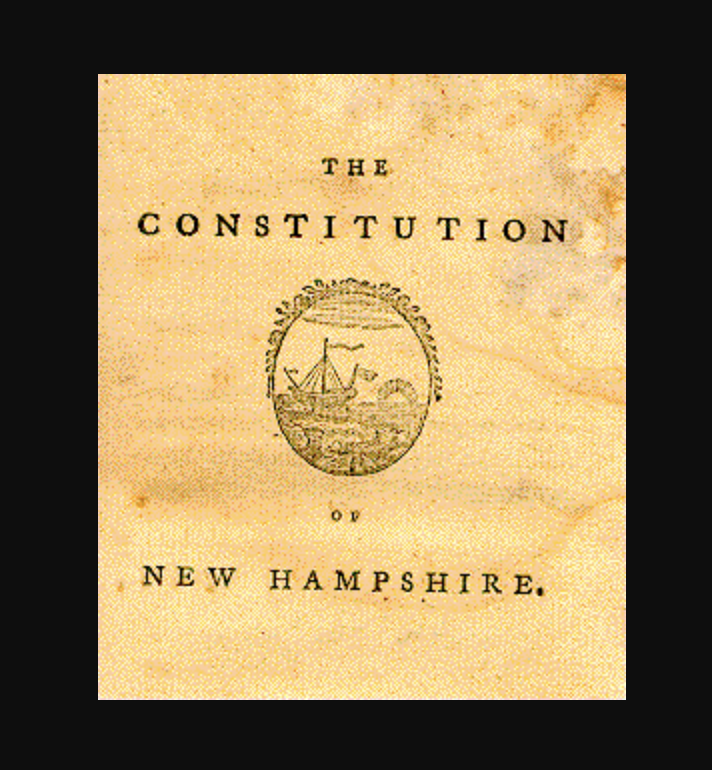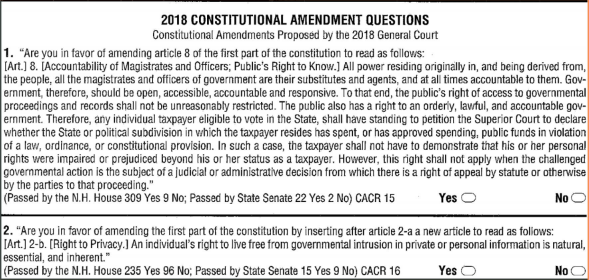GROK: Below, I’ll present a chart with the most recent amendments (from the prior response) and selected earlier amendments drawn from available sources, followed by an analysis of the concerns reflected in the amendment history. Due to the lack of a full catalog of all 149 amendments in the provided data, the chart will include placeholders for the remaining amendments and a summary of thematic concerns over time.
Chart: New Hampshire Constitutional Amendments (Selected, with Placeholders for 149 Total)
| Amendment Number | Date Approved | Effective Date | Article Amended/Added | Description | Key Concern | Source |
|---|---|---|---|---|---|---|
| 149 (Question 2) | November 6, 2018 | November 6, 2018 | Part I, Article 8 | Granted taxpayers standing to sue state or local governments for unlawful spending without showing personal harm, enhancing government accountability. | Government accountability, taxpayer rights | |
| 148 (Question 1) | November 6, 2018 | November 6, 2018 | Part I, Article 2-b | Established a right to privacy, protecting against governmental intrusion in personal information unless justified by a compelling state interest. | Privacy in the digital age | |
| 147 (Question 2) | November 7, 2006 | November 7, 2006 | Part II, Article 11 | Ensured towns with sufficient population for one representative have their own, allowing floterial districts for apportionment fairness. | Fair representation, redistricting | |
| 146 (Question 1) | November 7, 2006 | November 7, 2006 | Part II, Article 12-a | Limited eminent domain to public use, preventing private development takings, in response to Kelo v. City of New London. | Property rights, eminent domain | |
| 145 | November 5, 2002 | November 5, 2002 | Part II, Article 73-a | Clarified Supreme Court’s administrative and rulemaking authority, ensuring judicial independence. | Judicial autonomy, separation of powers | |
| 144 | November 3, 1992 | November 3, 1992 | Part II, Article 27 | Addressed senatorial district apportionment for fair representation. | Fair representation, redistricting | |
| 143 | November 6, 1984 | November 28, 1984 | Part I, Article 36-a | Ensured employer contributions to the NH retirement system are used solely for retirement benefits. | Public employee pension protection | |
| 142–1 (placeholders) | Various (1784–1984) | Various | Various | Amendments addressing voting rights, education funding, religious freedom, judicial tenure, and more. Examples include: <ul><li>1976 (Part I, Article 11): Lowered voting age to 18 and ensured accessibility to polling places. (Voting rights, accessibility)</li><li>1968 (Part I, Article 11): Removed nonpayment of taxes as a barrier to voting. (Voting rights, equity)</li><li>1912 (Part I, Article 11): Prohibited voting by those convicted of treason or bribery. (Election integrity)</li><li>1903 (Part II, Article 83): Empowered state to regulate economic activity. (Economic regulation)</li><li>1877 (Part II, Article 83): Prohibited state funding for religious schools. (Separation of church and state)</li></ul> | Diverse: voting rights, education, religion, governance | , |
| Total: 149 Amendments | 1784–2018 | 1784–2018 | Full list unavailable; includes policy changes (e.g., rights, governance) and clerical updates (e.g., gender neutrality). | Varied societal and governance issues | , |
Notes on the Chart
- Total Amendments: The New Hampshire Constitution has been amended 149 times as of 2018, per Ballotpedia. The exact number may vary slightly in older sources (e.g., Susan Marshall’s 2011 count of 144 through 1990).,
- Data Gaps: A complete list of all 149 amendments, with precise dates and descriptions, is not available in the provided sources or the Granite State Poll document. The chart includes the last seven amendments (from the prior response) and selected earlier examples from web sources, with placeholders for the remaining 142 amendments.
- Sources: Data is drawn from Ballotpedia, Wikipedia, NH.gov, and the prior response. Susan Marshall’s book (The New Hampshire State Constitution) is cited as a comprehensive source for amendment details but was not directly accessed here.,,,
- Amendment Process: Amendments require a 60% vote in both legislative chambers and two-thirds voter approval at the next biennial November election. This rigorous process limits the frequency of amendments.,
- Effective Dates: Typically, amendments take effect upon voter approval unless otherwise specified (e.g., 1984 pension amendment effective November 28, 1984).
- Placeholders: For amendments 1–142, specific details are summarized thematically due to lack of a complete catalog. Examples are included to illustrate recurring concerns.
Analysis of Concerns Reflected in Amendment History
The 149 amendments to the New Hampshire Constitution reflect evolving societal, political, and governance concerns over more than two centuries. Below are the key themes and concerns, inferred from the chart and broader sources, with examples tied to specific amendments where possible:
- Voting Rights and Electoral Integrity:
- Concern: Ensuring fair access to voting and protecting election integrity have been recurring issues, especially as societal norms evolved.
- Examples:
- 1976 (Part I, Article 11): Lowered voting age to 18 and mandated accessible polling places, reflecting national trends and accessibility concerns.
- 1968 (Part I, Article 11): Removed tax payment as a voting requirement, addressing equity in suffrage.
- 1912 (Part I, Article 11): Barred those convicted of treason or bribery from voting, emphasizing election integrity.
- Trend: Amendments often responded to federal changes (e.g., 19th Amendment, Voting Rights Act) or local demands for broader participation.
- Fair Representation and Redistricting:
- Concern: Apportionment of legislative districts to ensure equitable representation, especially in a state with small towns, has been a frequent issue.
- Examples:
- 2006 (Part II, Article 11): Allowed floterial districts while ensuring towns get their own representatives, addressing redistricting disputes.
- 1992 (Part II, Article 27): Adjusted senatorial district apportionment to reflect population changes.
- 2006 (Part II, Article 11): Allowed floterial districts while ensuring towns get their own representatives, addressing redistricting disputes.
- Trend: Redistricting amendments often follow litigation (e.g., 2002 state Supreme Court redistricting case) and aim to balance local control with fairness.
- Individual Rights and Liberties:
- Concern: Expanding or clarifying protections for personal freedoms, especially in response to technological or societal changes.
- Examples:
- 2018 (Part I, Article 2-b): Established a right to privacy, addressing concerns about government intrusion in the digital age.
- 1984 (Part I, Article 15): Added protections for those acquitted by reason of insanity and ensured counsel rights, reflecting due process concerns.
- 2018 (Part I, Article 2-b): Established a right to privacy, addressing concerns about government intrusion in the digital age.
- Trend: The Bill of Rights (Part I) has been amended regularly to codify specific protections, often more detailed than the U.S. Constitution.
- Government Accountability and Taxpayer Rights:
- Concern: Ensuring government transparency and protecting taxpayers from misuse of funds.
- Examples:
- 2018 (Part I, Article 8): Gave taxpayers standing to sue for unlawful spending, responding to a 2014 Supreme Court ruling limiting such suits.,
- 1976 (Part I, Article 8): Provided right of access to governmental proceedings and records, promoting transparency.
- 2018 (Part I, Article 8): Gave taxpayers standing to sue for unlawful spending, responding to a 2014 Supreme Court ruling limiting such suits.,
- Trend: These amendments reflect New Hampshire’s “Live Free or Die” ethos, emphasizing checks on government power.
- Property Rights and Economic Regulation:
- Concern: Protecting private property and defining the state’s role in economic oversight.
- Examples:
- 2006 (Part II, Article 12-a): Restricted eminent domain to public use, reacting to the Kelo decision.
- 1903 (Part II, Article 83): Authorized state regulation of economic activity, reflecting Progressive Era concerns.
- 2006 (Part II, Article 12-a): Restricted eminent domain to public use, reacting to the Kelo decision.
- Trend: Amendments often balance individual property rights with state authority, responding to national legal or economic shifts.
- Education and Public Welfare:
- Concern: Defining the state’s responsibility for education and public employee benefits.
- Examples:
- 1984 (Part I, Article 36-a): Protected retirement system contributions for public employees.
- 1877 (Part II, Article 83): Prohibited state funding for religious schools, reinforcing secular education.
- Trend: Education-related amendments, especially post-Claremont cases (1993–2009), addressed funding equity, though proposed amendments to limit judicial oversight failed.
- Judicial and Governance Structure:
- Concern: Clarifying the roles and independence of the judiciary and legislature.
- Examples:
- 2002 (Part II, Article 73-a): Strengthened Supreme Court’s administrative authority, ensuring separation of powers.
- 1792 (Part I, Article 35): Provided for judicial tenure with age limitations, balancing independence and accountability.
- Trend: Amendments often respond to disputes over judicial or legislative power, aiming to maintain checks and balances.
- Clerical and Modernization Updates:
- Concern: Updating language for clarity, gender neutrality, or modern governance needs.
- Examples: Amendments for gender-neutral language or minor procedural changes are noted but not detailed in sources.
- Trend: A significant portion of amendments address technical updates, reflecting the Constitution’s longevity and need for relevance.
Broader Observations
- Frequency: The 149 amendments over 234 years (1784–2018) average about 0.64 amendments per year, though they cluster around periods of social or legal change (e.g., early 20th century, post-Civil Rights era).
- Part I vs. Part II: The Bill of Rights (Part I) has been amended more frequently to expand individual protections, while the Form of Government (Part II) amendments focus on structural and procedural issues.
- Cultural Context: New Hampshire’s amendments reflect its independent, small-government ethos, with a focus on local control, taxpayer rights, and resistance to federal overreach (e.g., failed secession proposals like CACR 20 in 2024).
- Failed Amendments: Many proposed amendments, such as those for secession (2022, 2024) or judicial retirement age (2024), fail due to the high legislative and voter thresholds, indicating strong public and institutional resistance to radical change.
Limitations and Next Steps
- Incomplete Data: The lack of a full list of 149 amendments limits the chart’s comprehensiveness. Sources like the New Hampshire State Archives, the New Hampshire Manual for the General Court, or Marshall’s book could provide the missing details.
- Recommendation: For a complete chart, you could request records from the New Hampshire Law Library or consult The New Hampshire State Constitution by Susan E. Marshall, which includes an article-by-article commentary and amendment history.
- Granite State Poll Context: The NHExit poll highlights limited support for secession (12% in 2025), suggesting that amendments like CACR 20 (2024) reflect niche concerns rather than widespread sentiment. This underscores the challenge of passing radical amendments.
Conclusion
The New Hampshire Constitution’s 149 amendments address a wide range of concerns, from voting rights and representation to privacy, property, and government accountability. While the chart above is incomplete due to data limitations, it illustrates key themes that reflect New Hampshire’s commitment to individual liberty, local governance, and adaptive constitutionalism. If you’d like assistance accessing archival resources or focusing on a specific era or theme (e.g., 19th-century amendments), let me know, and I can tailor the response further!

